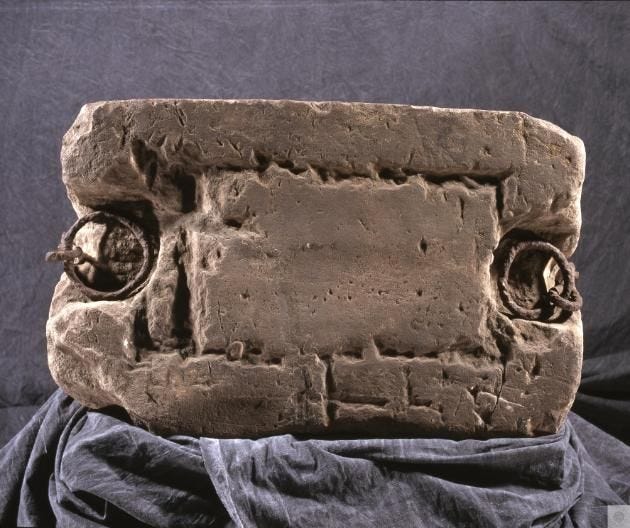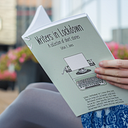The Stone of Destiny

A strange chain of events has recently come to light in a coroner’s report from the foothills of Scotland where, in late November 2018, a Highland Constabulary operation recovered a body from under a sphagnum-moss peat bog, one of a chain which thrive in daily run-off rainwater from the southern Grampian Mountains. As a protected Site of Special Scientific Interest (SSSI), the bog had lain undisturbed for many years until the discovery beneath the surface of a portable tin by popular restaurateur and amateur metal detectorist Alec Monteith in late summer, which prompted further investigation.
Matters were delayed pending the completion of an abbreviated environmental impact assessment before a warrant could be issued for the subsequent excavation, but reasonable suspicion that criminal evidence existed at the location presently achieved the appropriate clearance.
The level of preservation of organic materials, such as woody debris or soft tissue, in peat bogs is already well understood, with examples of so-called bog body discoveries in Ireland, Sweden and Denmark. Anaerobic conditions, the absence of oxygen, and the presence of tannic acid is a very effective combination in halting decomposition and this makes it difficult for researchers to assess with accuracy how long a body has been in position or the year of death. However, the season can generally be identified through pollen analysis of the human respiration system, e.g. the Erica bell heather. If the remains are not ancient, the approximate year of inhumation can often be estimated not just from the remains but also from the manufactured model and style of the clothing.
Weeks before the remains were discovered, the small rain-proof container from the original find had been opened by police laboratory technicians and was found to contain a notebook immersed in tannic bog-water. The writing was considered to be indecipherable when read conventionally, so this evidence proceeded to the National Archives Conservation Project at the University of St. Andrews.
Staff at the NACP, funded by the Scottish Government and the National Trust for Scotland, treated and fluoresced the pages of the notebook to reveal the handwriting of the deceased, which described a fascinating footnote to history and explained the case. With apologies for the abridgement, a summary of the trail which led to the entombment is as follows:
Audrey Carrick-Bell was a graduate student at the University of Stirling, where she studied the early development of Christianity in Scotland. Her dissertation on Celtic Crosses and the influence of St. Columba from 521–597 AD (founder of Iona Abbey and the first recorded person to claim sight of the Loch Ness Monster or Water Kelpie) earned her accolades beyond the academic community, comparatively unusual for undergraduate work.
When inspecting a bale-seal of Scotland, now in the Burrell Collection but at that time recently unearthed in the Ettrick border region, dated to a time soon after St. Columba arrived from Ireland in 574AD, Audrey’s careful notation tells us that the proportional measured height of the “kinging stone” (a relic on which the legitimacy of a coronation depended) or Stone of Scone depicted upon it was twice the dimension of the stone which had from 1286 to 1996 been held at the Palace of Westminster in London, representing English monarchical domination over the Scottish crown. It was also saddle-shaped and bore carved scroll-work in the bale-seal image, whereas the official Stone captured by Edward I of England was oblong and quite plain. Could there be two stones, she wondered, the genuine and the rushed copy?
Miss Bell then entered into an obsessive and well planned solo quest, as detailed in her thorough note keeping. She ascertained that the official Stone of Scone had been cut from matching stone in the vicinity of Scone Abbey, which was not compatible with the theory that it had been transported from Ireland (or meteoric rock from Egypt, as some versions had it). From historical records, she then questioned how a stone that needed six highland Scots to lift it only required two people now.
Miss Bell then pursued the theory derived from study of the Kincaid fortification on the River Tay, near to Scone, which had it that the coat of arms of the Kincaids showed a stone and three inflated sheep skins, speculating that these tools may have been used to float the real Stone of Scone across the Tay ahead of King Edward’s arrival, when the false stone may have been carved with haste and surrendered to the invader.
The Kincaid theory had it that “Columba knows” where the real Stone rests, which Miss Bell took to mean a columbine or dove coat was the burial place, often situated on the tops of hills. After a summer spent excavating test pits at the top of hills in the area, Miss Bell concluded that the Stone was not present. Her handwritten records tell us that she then speculated where the Stone could be hidden if it was found to be too unwieldy to transport to the summit of a hill.
Following the educated guess that the English force would be departing southward to Halifax or York, it seemed reasonable to assume that crossing the Tay to the south would be counter-intuitive and the area it would be least likely to be discovered would be to the north and the fastness of the Grampians.
Camping in this region in the summer of that year, Miss Bell estimated it would be impossible, both then and now, to cross the peat bogs and marshes with so heavy an encumbrance. Neither could such an important relic be taken back, in the historical context, due to the realistic threat of capture. Therefore, Miss Bell theorised with what she considered to be a high level of probability, the real Stone of Scone, unseen for precisely 700 years, could still be set within the sphagnum bog that blocked the pass at the base of the valley. As an SSSI with an Environmental Protection Order in place, the work she intended to carry out at this location was and still is unlawful.
Disregarding the ignorant superstition of the local community, trusting in the anonymity of the site’s isolation and unwilling to share the discovery with any of her peers, Audrey Carrick-Bell proceeded to the wetmarsh mire with a stout garden spade on Friday 13th June 1986 and began to dig.
